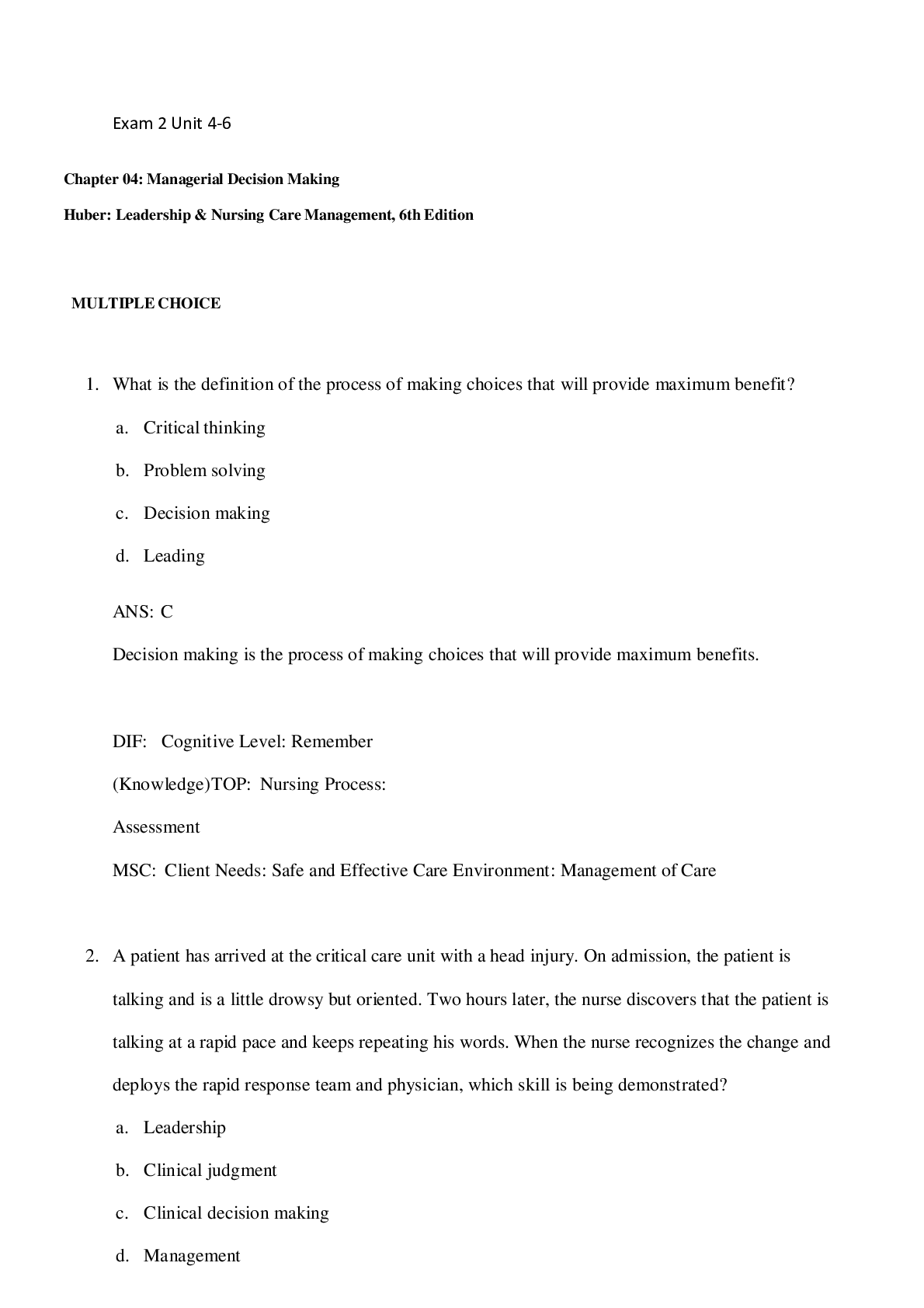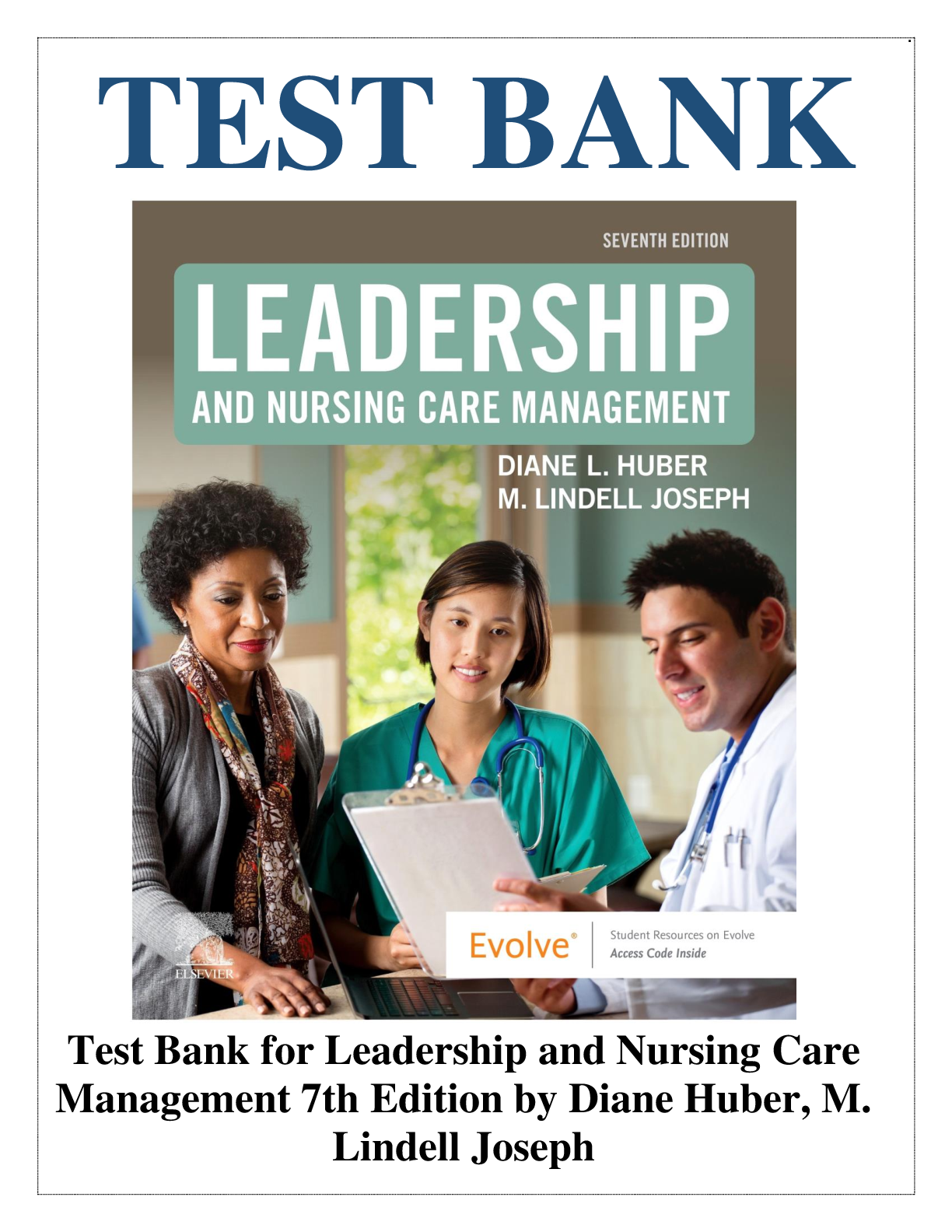*NURSING > QUESTIONS & ANSWERS > Leadership & Nursing Care Management, 6th Edition (All)
Leadership & Nursing Care Management, 6th Edition
Document Content and Description Below
1. Which of these statements are true about culture? a. Culture remains consistent. b. Individuals identify with one culture during their lifetime. c. Culture is complex. d. Culture excludes relig... ion. ANS: C Culture is dynamic in nature, and individuals may identify with multiple cultures over the course of their lifetimes. There is a complex nature to culture, which has been defined and studied across many disciplines. DIF: Cognitive Level: Remember (Knowledge) TOP: Nursing Process: Assessment MSC: Client Needs: Physiological Integrity: Basic Care and Comfort 2. A client of Vietnamese background is admitted to the unit after a hysterectomy. She has an order for clear liquids. When her tray is brought to her, she refuses the lime Jell-O. Which response by the nurse is most appropriate? a. “I don’t blame you. I don’t like lime Jell-O either.” b. “Tell me about your cultural beliefs to best help you.” c. “Why don’t you want to eat the lime Jell-O?” d. “It is important for you to eat so that you will heal.” ANS: B The first step toward multicultural competence is to recognize one’s own prejudices and learn about other people’s differences. The problem is that many Americans are afraid to ask people about their culture because of the idea that “we don’t want to offend anyone.” The challenge with this thinking is that if nurses do not ask about people’s differences, then the only option is to make assumptions. DIF: Cognitive Level: Apply (Application) TOP: Nursing Process: Assessment MSC: Client Needs: Safe and Effective Care Environment: Management of Care 3. Cultural diversity refers to the: a. variety of cultural or ethnic groups within a society. b. belief that one’s own culture is similar to another’s culture. c. realization that all people in a particular culture have the same beliefs. d. view that individuals living in a country should speak the native language. ANS: A Cultural diversity is defined by the Oxford Dictionary (“Cultural diversity,” 2016) as “The existence of a variety of cultural or ethnic groups within a society.” DIF: Cognitive Level: Understand (Comprehension) TOP: Nursing Process: Assessment NURSINGTB.COM Leadership and Nursing Care Management 6th Edition Huber Test Bank NU RS IN GT B.CO M MSC: Client Needs: Safe and Effective Care Environment: Management of Care 4. Which of these is the fastest growing minority group in the United States? a. Asians b. Caucasians c. Blacks d. Hispanics ANS: D The U.S. Census Bureau (2014) estimates that minorities (anyone who is not a single-race non-Hispanic White) will be the majority in America by 2044 as a result of both immigration and growth rate. The nation’s racial and ethnic minority groups, especially Hispanics, are growing more rapidly than the non-Hispanic White population, fueled by both immigration and births. DIF: Cognitive Level: Remember (Knowledge) TOP: Nursing Process: Assessment MSC: Client Needs: Safe and Effective Care Environment: Management of Care 5. Which of the following ethnic populations has seen the fastest growth? a. African Americans b. Iranians c. Hispanics d. Vietnamese ANS: C Results from the 2010 census show that racial and ethnic minorities accounted for 91.7% of the nation’s growth since 2000. Most of that increase, from 2000 to 2010 (56%), was due to Hispanics. DIF: Cognitive Level: Remember (Knowledge) TOP: Nursing Process: Assessment MSC: Client Needs: Safe and Effective Care Environment: Management of Care 6. Equity is the absence of avoidable differences among groups of people, whether those groups are defined socially, economically, demographically, or geographically. Which group formulated this definition? a. World Health Organization b. Affordable Care Act c. Centers for Disease Control d. Agency for Healthcare Research and Quality ANS: A According to the World Health Organization (2016), “Equity is the absence of avoidable or remediable differences among groups of people, whether those groups are defined socially, economically, demographically or geographically.” DIF: Cognitive Level: Remember (Knowledge) TOP: Nursing Process: Assessment MSC: Client Needs: Safe and Effective Care Environment: Management of Care NURSINGTB.COM Leadership and Nursing Care Management 6th Edition Huber Test Bank NU RS IN GT B.CO M 7. Recognizing one’s own prejudices and learning about other people’s differences is the first step toward: a. cultural diversity. b. multicultural competence. c. social change. d. valuing. ANS: B To reduce cross-cultural miscommunications and improve patient satisfaction, the multicultural competence of health care practitioners needs to be improved. The first step toward multicultural competence is to recognize one’s own prejudices and learn about other people’s differences. DIF: Cognitive Level: Apply (Application) TOP: Nursing Process: Planning MSC: Client Needs: Safe and Effective Care Environment: Management of Care 8. A nurse believes that she should provide optimal care to all clients, regardless of their cultural background. She is struggling with her emotions when caring for a client with a violent criminal background. What would be the best course of action for this nurse? a. Avoiding the client as much as possible but providing care b. Identifying her biases but providing care c. Requesting another patient assignment d. Taking sick days while the patient is hospitalized ANS: B The first step toward multicultural competence is to recognize one’s own prejudices and learn about other people’s differences. The problem is that many Americans are afraid to ask people about their culture because of the idea that “we don’t want to offend anyone.” The challenge with this thinking is that if nurses do not ask about people’s differences, then the only option is to make assumptions. DIF: Cognitive Level: Apply (Application) TOP: Nursing Process: Assessment MSC: Client Needs: Safe and Effective Care Environment: Management of Care 9. Which of the following supports successful workplace diversity? a. Being a “devil’s advocate” b. Holding tight to one’s cultural values c. Respect for differences d. Withholding judgment of others ANS: C To reduce cross-cultural miscommunications and improve patient satisfaction, the multicultural competence of health care practitioners needs to be improved. The first step toward multicultural competence is to recognize one’s own prejudices and learn about other people’s differences. DIF: Cognitive Level: Apply (Application) TOP: Nursing Process: Assessment MSC: Client Needs: Safe and Effective Care Environment: Management of Care NURSINGTB.COM Leadership and Nursing Care Management 6th Edition Huber Test Bank NU RS IN GT B.CO M 10. According to the National Healthcare Quality and Disparities Report, which group has worse access to health care in America, compared with Whites? a. Hispanics b. Asians c. Blacks d. American Indians ANS: A According to the 2014 National Healthcare Quality and Disparities Report (Agency for Healthcare Research and Quality [AHRQ], 2015), “Historically, Americans have experienced variable access to care based on race, ethnicity, socioeconomic status, age, sex, disability status, sexual orientation, and residence location.” This study found that Blacks had worse access to health care than Whites for about half of measures of access, Hispanics had worse access to care than Whites for two-thirds of access measures, and Asians and American Indians and Alaska Natives had worse access to care than Whites for about one-third of access measures. DIF: Cognitive Level: Remember (Knowledge) TOP: Nursing Process: Assessment MSC: Client Needs: Safe and Effective Care Environment: Management of Care [Show More]
Last updated: 2 years ago
Preview 1 out of 165 pages

Buy this document to get the full access instantly
Instant Download Access after purchase
Buy NowInstant download
We Accept:

Reviews( 0 )
$7.00
Can't find what you want? Try our AI powered Search
Document information
Connected school, study & course
About the document
Uploaded On
Apr 24, 2022
Number of pages
165
Written in
Additional information
This document has been written for:
Uploaded
Apr 24, 2022
Downloads
0
Views
122


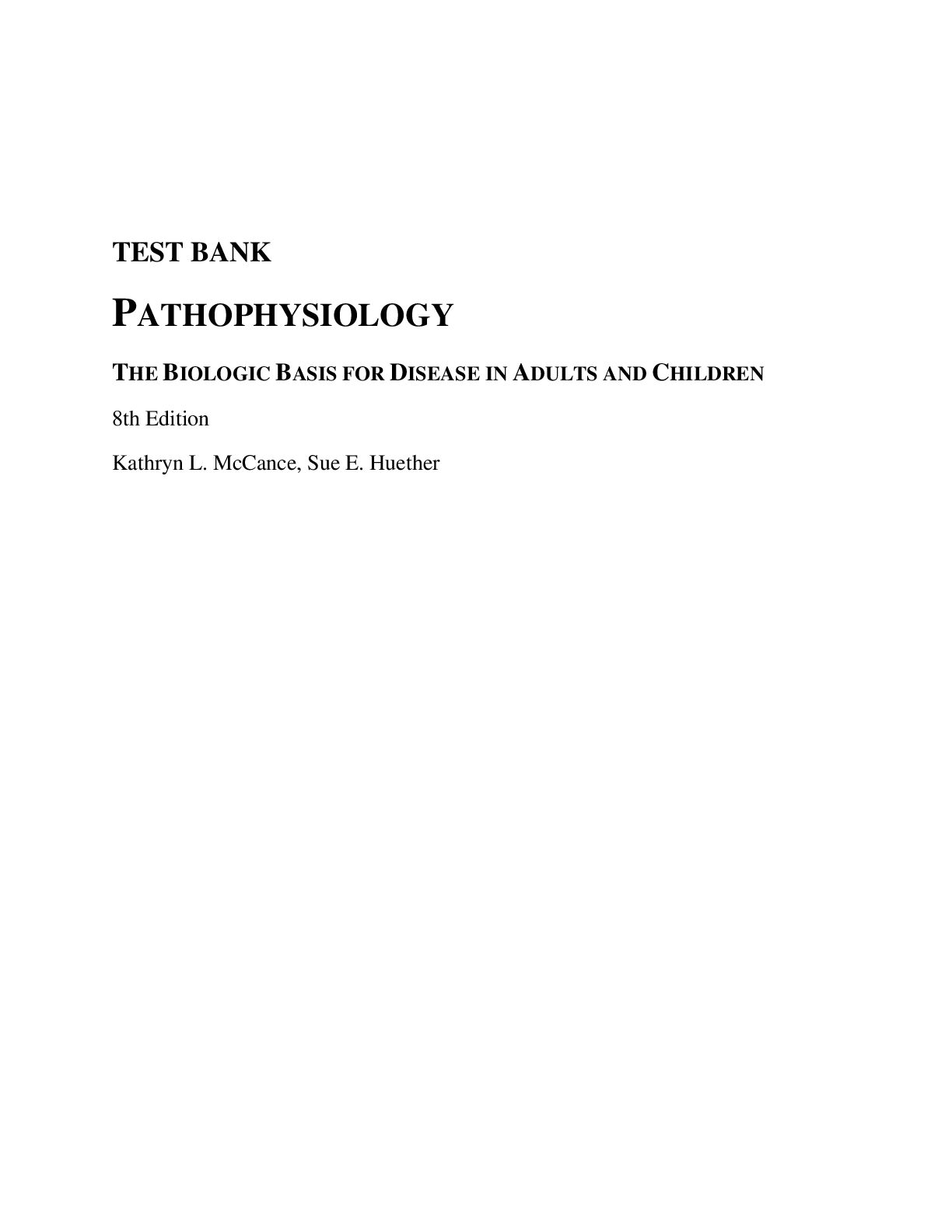


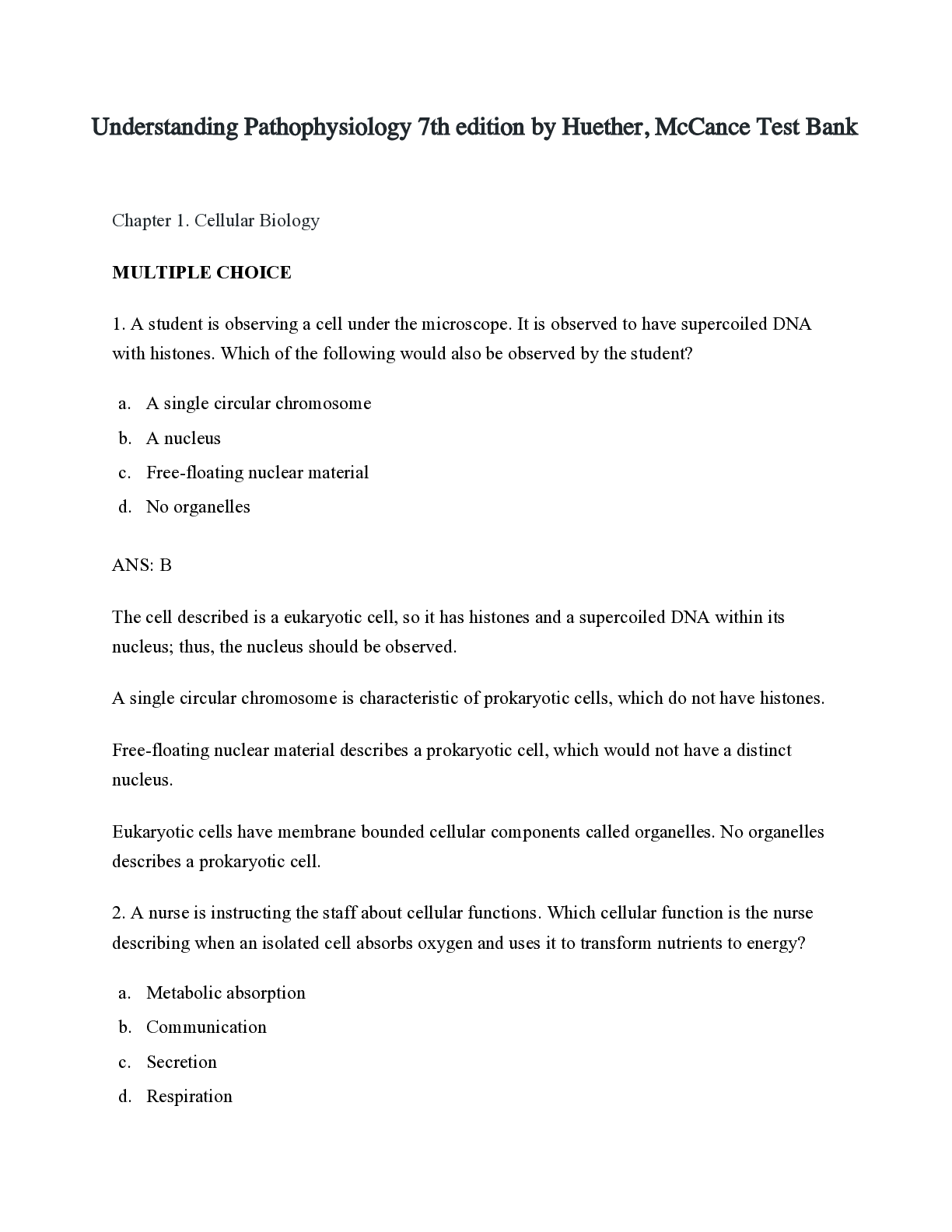
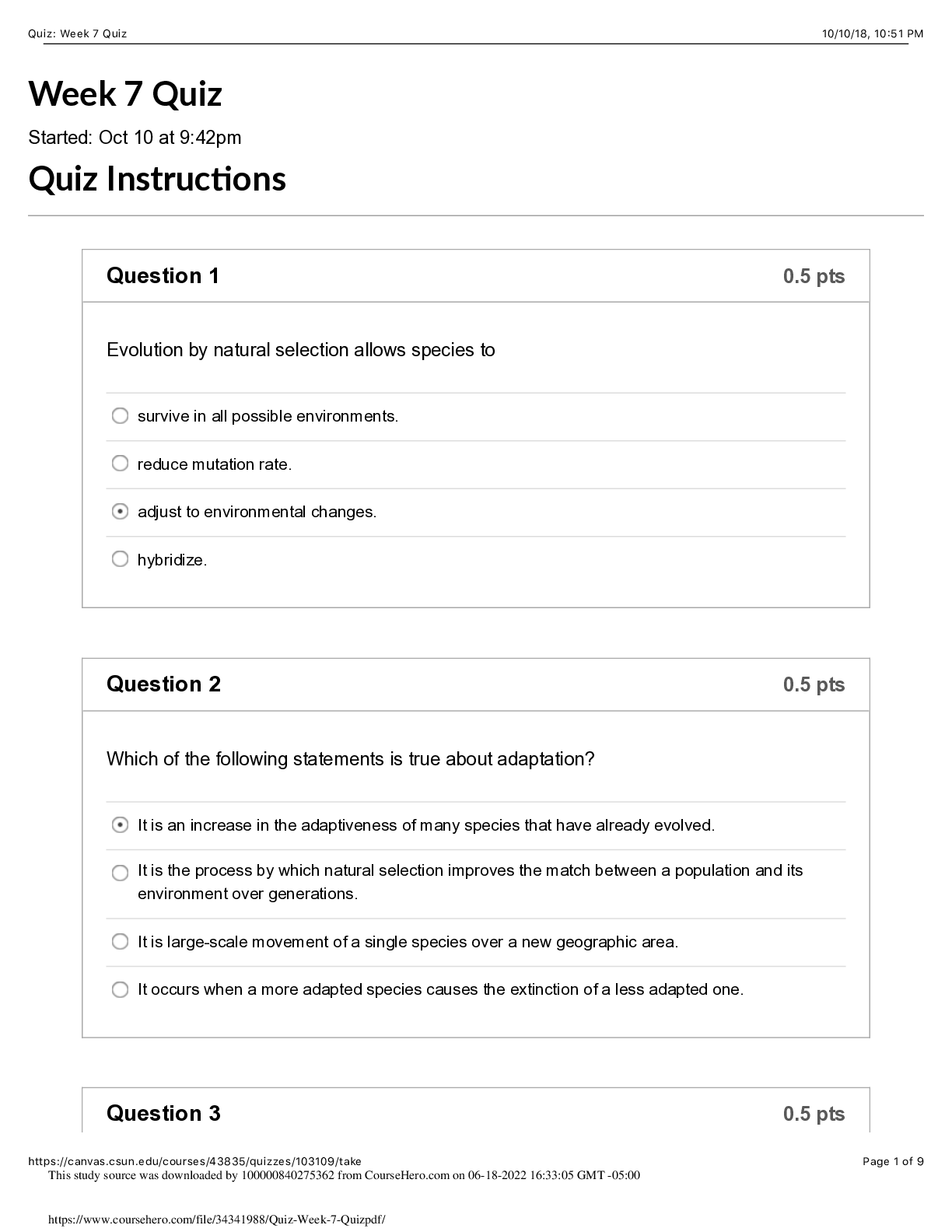
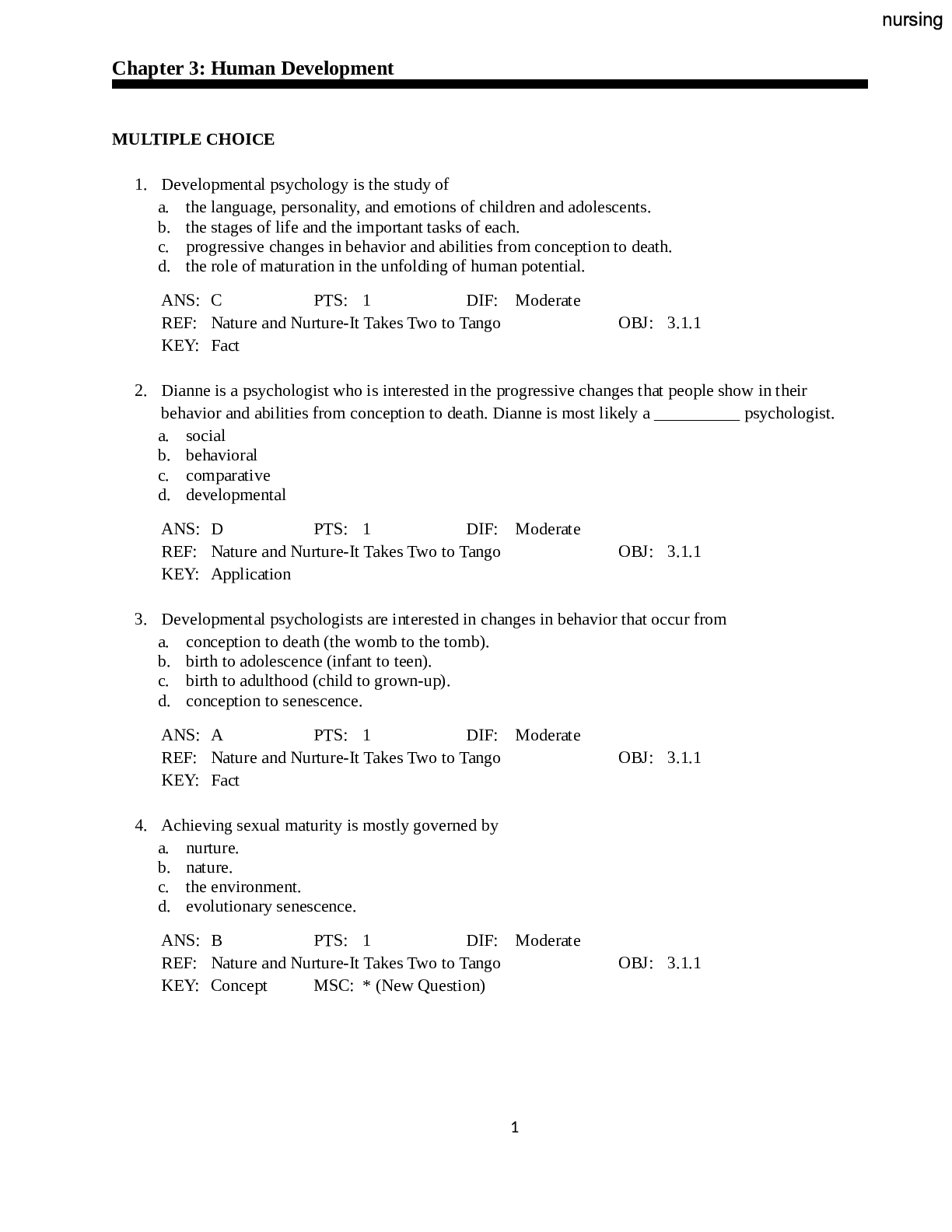

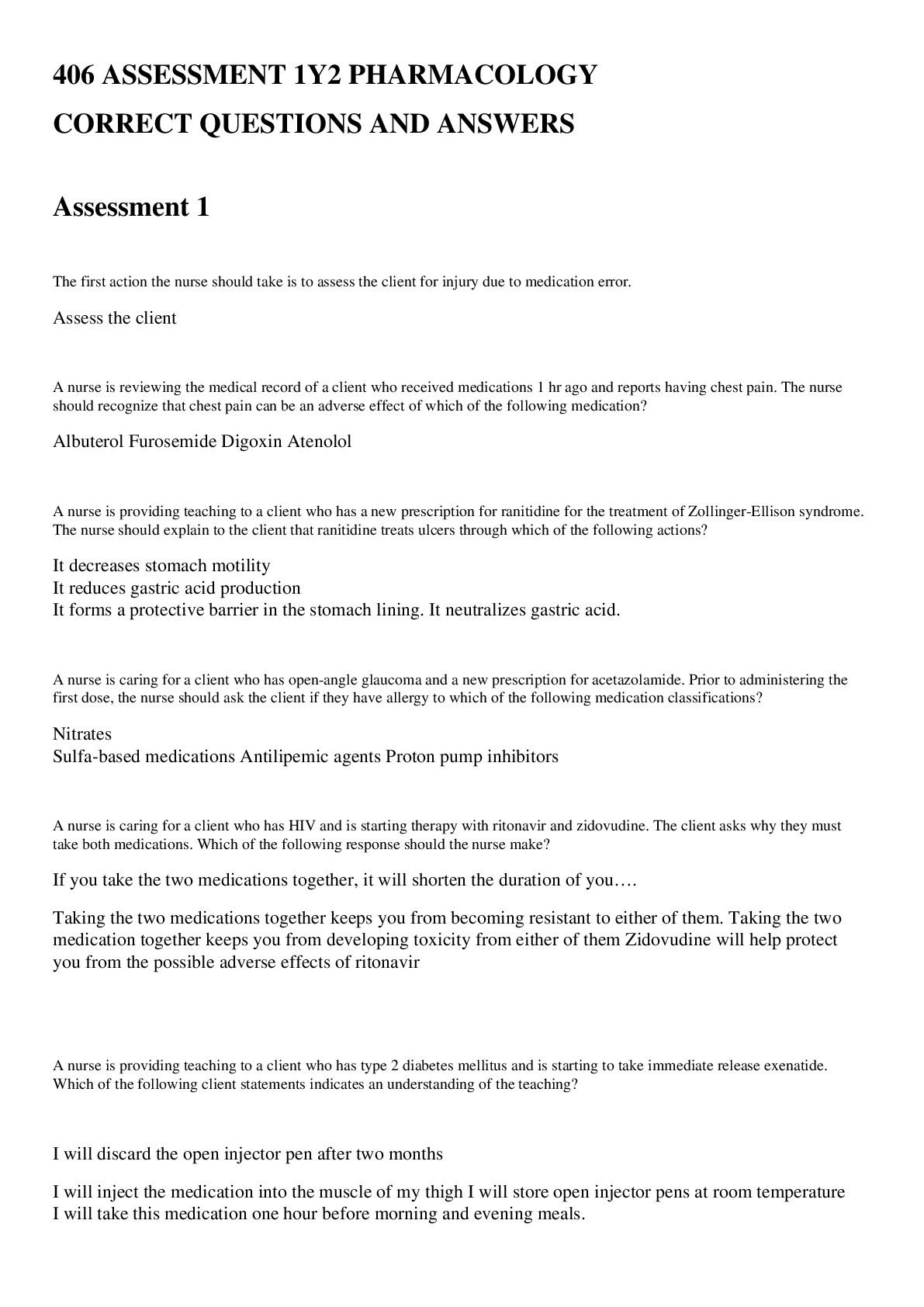
.png)


